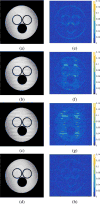Efficient Sum of Outer Products Dictionary Learning (SOUP-DIL) and Its Application to Inverse Problems
- PMID: 29376111
- PMCID: PMC5786175
- DOI: 10.1109/TCI.2017.2697206
Efficient Sum of Outer Products Dictionary Learning (SOUP-DIL) and Its Application to Inverse Problems
Abstract
The sparsity of signals in a transform domain or dictionary has been exploited in applications such as compression, denoising and inverse problems. More recently, data-driven adaptation of synthesis dictionaries has shown promise compared to analytical dictionary models. However, dictionary learning problems are typically non-convex and NP-hard, and the usual alternating minimization approaches for these problems are often computationally expensive, with the computations dominated by the NP-hard synthesis sparse coding step. This paper exploits the ideas that drive algorithms such as K-SVD, and investigates in detail efficient methods for aggregate sparsity penalized dictionary learning by first approximating the data with a sum of sparse rank-one matrices (outer products) and then using a block coordinate descent approach to estimate the unknowns. The resulting block coordinate descent algorithms involve efficient closed-form solutions. Furthermore, we consider the problem of dictionary-blind image reconstruction, and propose novel and efficient algorithms for adaptive image reconstruction using block coordinate descent and sum of outer products methodologies. We provide a convergence study of the algorithms for dictionary learning and dictionary-blind image reconstruction. Our numerical experiments show the promising performance and speedups provided by the proposed methods over previous schemes in sparse data representation and compressed sensing-based image reconstruction.
Keywords: Compressed sensing; Convergence analysis; Dictionary learning; Fast algorithms; Inverse problems; Sparsity.
Figures






Similar articles
-
Low-Rank and Adaptive Sparse Signal (LASSI) Models for Highly Accelerated Dynamic Imaging.IEEE Trans Med Imaging. 2017 May;36(5):1116-1128. doi: 10.1109/TMI.2017.2650960. Epub 2017 Jan 10. IEEE Trans Med Imaging. 2017. PMID: 28092528 Free PMC article.
-
Fourier Domain Robust Denoising Decomposition and Adaptive Patch MRI Reconstruction.IEEE Trans Neural Netw Learn Syst. 2024 Jun;35(6):7299-7311. doi: 10.1109/TNNLS.2022.3222394. Epub 2024 Jun 3. IEEE Trans Neural Netw Learn Syst. 2024. PMID: 37015441
-
Sparsity-promoting orthogonal dictionary updating for image reconstruction from highly undersampled magnetic resonance data.Phys Med Biol. 2015 Jul 21;60(14):5359-80. doi: 10.1088/0031-9155/60/14/5359. Epub 2015 Jun 25. Phys Med Biol. 2015. PMID: 26110788
-
An Algorithm Combining Analysis-based Blind Compressed Sensing and Nonlocal Low-rank Constraints for MRI Reconstruction.Curr Med Imaging Rev. 2019;15(3):281-291. doi: 10.2174/1573405614666180130151333. Curr Med Imaging Rev. 2019. PMID: 31989879 Review.
-
A Dictionary of Chemistry.Med Chir Rev J Med Sci Anal Ser. 1821 Sep 1;2(6):315-326. Med Chir Rev J Med Sci Anal Ser. 1821. PMID: 29917450 Free PMC article. Review. No abstract available.
Cited by
-
Wasserstein GANs for MR Imaging: From Paired to Unpaired Training.IEEE Trans Med Imaging. 2021 Jan;40(1):105-115. doi: 10.1109/TMI.2020.3022968. Epub 2020 Dec 29. IEEE Trans Med Imaging. 2021. PMID: 32915728 Free PMC article.
-
Online Adaptive Image Reconstruction (OnAIR) Using Dictionary Models.IEEE Trans Comput Imaging. 2020;6:153-166. doi: 10.1109/tci.2019.2931092. IEEE Trans Comput Imaging. 2020. PMID: 32095490 Free PMC article.
-
A dictionary-based graph-cut algorithm for MRI reconstruction.NMR Biomed. 2020 Dec;33(12):e4344. doi: 10.1002/nbm.4344. Epub 2020 Jul 2. NMR Biomed. 2020. PMID: 32618082 Free PMC article.
-
Image Reconstruction: From Sparsity to Data-adaptive Methods and Machine Learning.Proc IEEE Inst Electr Electron Eng. 2020 Jan;108(1):86-109. doi: 10.1109/JPROC.2019.2936204. Epub 2019 Sep 19. Proc IEEE Inst Electr Electron Eng. 2020. PMID: 32095024 Free PMC article.
-
Blind Primed Supervised (BLIPS) Learning for MR Image Reconstruction.IEEE Trans Med Imaging. 2021 Nov;40(11):3113-3124. doi: 10.1109/TMI.2021.3093770. Epub 2021 Oct 27. IEEE Trans Med Imaging. 2021. PMID: 34191725 Free PMC article.
References
-
- Elad M, Milanfar P, Rubinstein R. Analysis versus synthesis in signal priors. Inverse Problems. 2007;23(3):947–968.
-
- Candès EJ, Eldar YC, Needell D, Randall P. Compressed sensing with coherent and redundant dictionaries. Applied and Computational Harmonic Analysis. 2011;31(1):59–73.
-
- Pratt WK, Kane J, Andrews HC. Hadamard transform image coding. Proc IEEE. 1969;57(1):58–68.
-
- Ravishankar S, Bresler Y. Learning sparsifying transforms. IEEE Trans Signal Process. 2013;61(5):1072–1086. - PubMed
-
- Liu Y, Cai J-F, Zhan Z, Guo D, Ye J, Chen Z, Qu X. Balanced sparse model for tight frames in compressed sensing magnetic resonance imaging. PLOS ONE. 2015 Apr;10(4):1–19. [Online]. Available: http://dx.doi.org/10.1371%2Fjournal.pone.0119584. - PMC - PubMed
Grants and funding
LinkOut - more resources
Full Text Sources
Other Literature Sources
Miscellaneous
